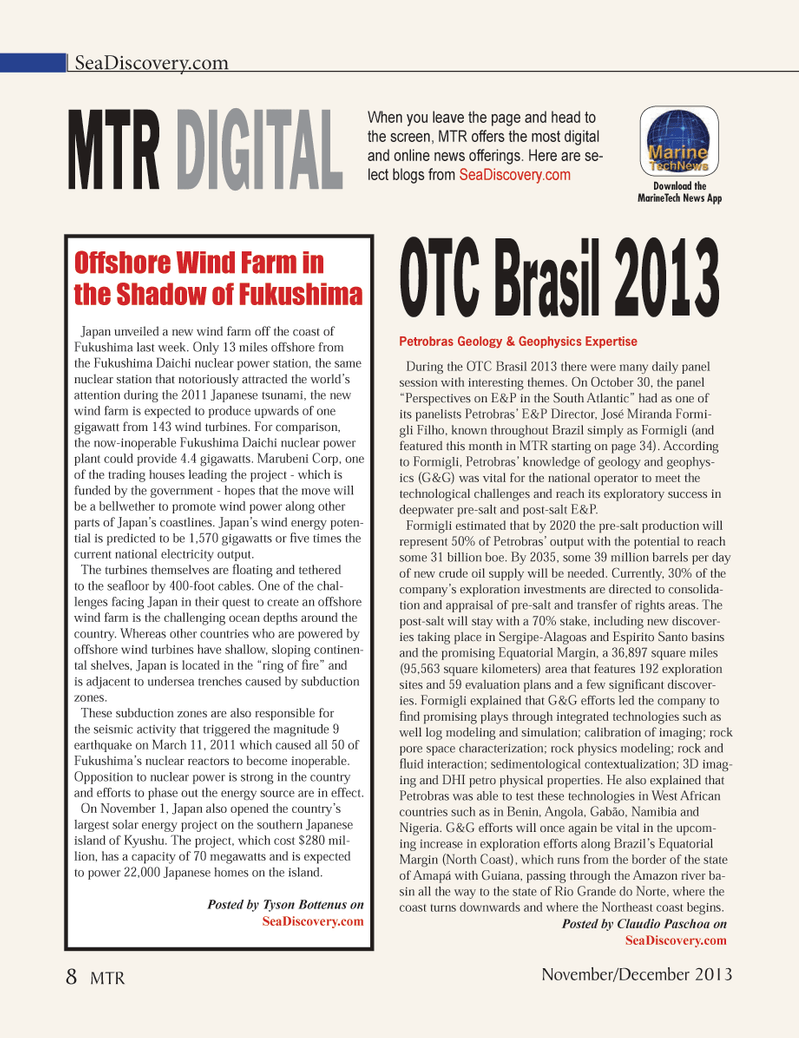
Page 8: of Marine Technology Magazine (November 2013)
Fresh Water Monitoring & Sensors
Read this page in Pdf, Flash or Html5 edition of November 2013 Marine Technology Magazine
SeaDiscovery.com During the OTC Brasil 2013 there were many daily panel session with interesting themes. On October 30, the panel ?Perspectives on E&P in the South Atlantic? had as one of its panelists Petrobras? E&P Director, José Miranda Formi- gli Filho, known throughout Brazil simply as Formigli (and featured this month in MTR starting on page 34). According to Formigli, Petrobras? knowledge of geology and geophys- ics (G&G) was vital for the national operator to meet the technological challenges and reach its exploratory success in deepwater pre-salt and post-salt E&P. Formigli estimated that by 2020 the pre-salt production will represent 50% of Petrobras? output with the potential to reach some 31 billion boe. By 2035, some 39 million barrels per day of new crude oil supply will be needed. Currently, 30% of the company?s exploration investments are directed to consolida- tion and appraisal of pre-salt and transfer of rights areas. The post-salt will stay with a 70% stake, including new discover- ies taking place in Sergipe-Alagoas and Espirito Santo basins and the promising Equatorial Margin, a 36,897 square miles (95,563 square kilometers) area that features 192 exploration sites and 59 evaluation plans and a few signi cant discover- ies. Formigli explained that G&G efforts led the company to nd promising plays through integrated technologies such as well log modeling and simulation; calibration of imaging; rock pore space characterization; rock physics modeling; rock and uid interaction; sedimentological contextualization; 3D imag- ing and DHI petro physical properties. He also explained that Petrobras was able to test these technologies in West African countries such as in Benin, Angola, Gabão, Namibia and Nigeria. G&G efforts will once again be vital in the upcom- ing increase in exploration efforts along Brazil?s Equatorial Margin (North Coast), which runs from the border of the state of Amapá with Guiana, passing through the Amazon river ba- sin all the way to the state of Rio Grande do Norte, where the coast turns downwards and where the Northeast coast begins. Posted by Claudio Paschoa on SeaDiscovery.com MTR DIGITAL When you leave the page and head to the screen, MTR offers the most digital and online news offerings. Here are se- lect blogs from SeaDiscovery.com Offshore Wind Farm in the Shadow of FukushimaJapan unveiled a new wind farm off the coast of Fukushima last week. Only 13 miles offshore from the Fukushima Daichi nuclear power station, the same nuclear station that notoriously attracted the world?s attention during the 2011 Japanese tsunami, the new wind farm is expected to produce upwards of one gigawatt from 143 wind turbines. For comparison, the now-inoperable Fukushima Daichi nuclear power plant could provide 4.4 gigawatts. Marubeni Corp, one of the trading houses leading the project - which is funded by the government - hopes that the move will be a bellwether to promote wind power along other parts of Japan?s coastlines. Japan?s wind energy poten- tial is predicted to be 1,570 gigawatts or ve times the current national electricity output. The turbines themselves are oating and tethered to the sea oor by 400-foot cables. One of the chal- lenges facing Japan in their quest to create an offshore wind farm is the challenging ocean depths around the country. Whereas other countries who are powered by offshore wind turbines have shallow, sloping continen- tal shelves, Japan is located in the ?ring of re? and is adjacent to undersea trenches caused by subduction zones. These subduction zones are also responsible for the seismic activity that triggered the magnitude 9 earthquake on March 11, 2011 which caused all 50 of Fukushima?s nuclear reactors to become inoperable. Opposition to nuclear power is strong in the country and efforts to phase out the energy source are in effect. On November 1, Japan also opened the country?s largest solar energy project on the southern Japanese island of Kyushu. The project, which cost $280 mil- lion, has a capacity of 70 megawatts and is expected to power 22,000 Japanese homes on the island. Posted by Tyson Bottenus on SeaDiscovery.com OTC Brasil 2013Petrobras Geology & Geophysics Expertise Download the MarineTech News App November/December 20138 MTRMTR #9 (1-17).indd 8MTR #9 (1-17).indd 812/12/2013 4:27:58 PM12/12/2013 4:27:58 PM

 7
7

 9
9
